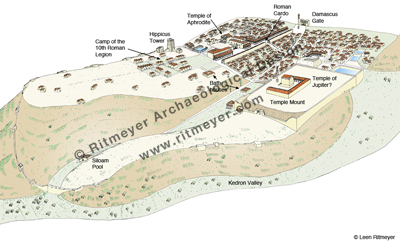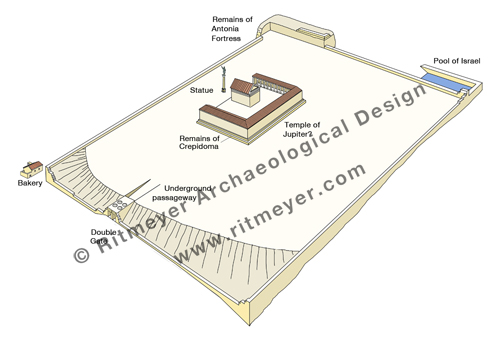We have now arrived at the Roman period in our sequence of reconstruction drawings showing how the Temple Mount developed over time. After the Roman destruction of Jerusalem in 70. A.D., the area of the Temple Mount lay desolate. In 130 AD, Emperor Hadrian began to build a Roman colony named Aelia Capitolina, on the ruins of Jerusalem.

The name Aelia was given in honor of the emperor’s family name, which was Aelius, while the name Capitolina honored the deities of the Capitoline triad: Jupiter, Juno and Minerva.
Hadrian’s actions precipitated the Revolt of Bar Kokhba (“Son of a Star”), which began in 132 AD. Some Jews regarded Bar Kokhba as the promised Messiah. Plans were made to rebuild the Temple and coins depicting it were struck. It is unclear how far these plans materialized. Following the suppression of the revolt in 135 AD, the pagan city of Aelia Capitolina became reality. A sanctuary to Jupiter may have been erected on the Temple Mount.

The remains of three long steps that are no longer visible but which were marked on plans made by Sir Charles Warren, may have belonged to the southern part of the crepidoma (stepped platform) of this presumed temple.

Jews were forbidden from entering the city on pain of death and Hadrian tried further to erase their connection to the Land by changing the name of Judea to Syria Palaestina (whence the name Palestine).
The reconstruction drawing above is the 8th in this series that was made specially for our new Temple Mount guide book that is awaiting publication. For the previous drawings see: Mount Moriah, Jebusites, Solomon, Hezekiah, Nehemiah, the Hellenistic and Hasmonean periods and the Herodian period.

One thought on “The Temple Mount during the Roman period”